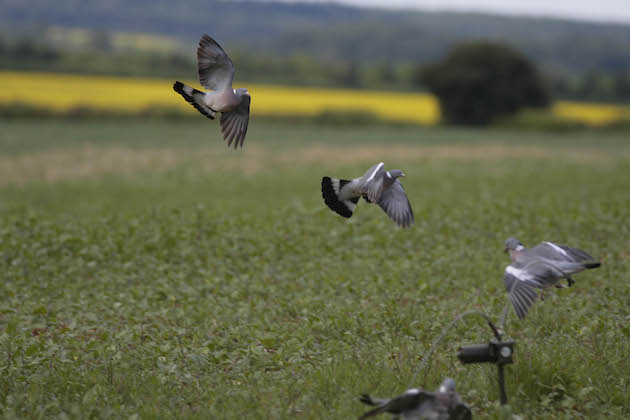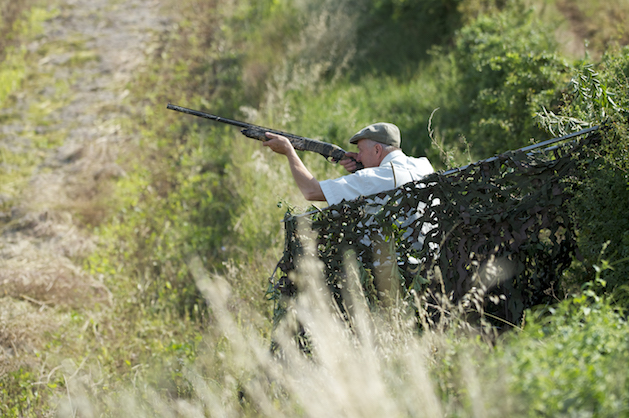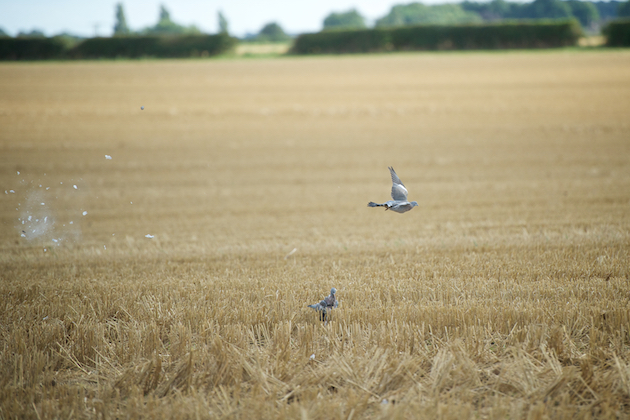The latest reactions to withdrawal of the general licences
Farmers, gamekeepers and recreational shooters have reacted with a mixture of anger and confusion to the decision by Natural England…
Win CENS ProFlex DX5 earplugs worth £1,149 – enter here
 A pair of woodpigeons coming into the magnet.
Usd 20 august 14 pigeon shooting
Usd 26 april 17 pigeon shooting
A pair of woodpigeons coming into the magnet.
Usd 20 august 14 pigeon shooting
Usd 26 april 17 pigeon shooting
Perhaps this is a good time to pause and ask a question: do we really need to shoot woodpigeons? If the general licence fiasco has reminded us of anything, it is that for pigeons to be controlled, they must be doing not just damage, but serious damage. So is this the case?
In trying to answer this question I made one rule; I wasn’t going to ask pigeon shooters. Of course they will say pigeons are destructive, damaging pests. To avoid any accusation of bias, I have garnered the views of agronomists, farmers, economists and scientists but strictly no pigeon shooters.

The last time anybody calculated the scale of woodpigeon damage across the UK was in 1989, when a total was worked out for oilseed rape, and even then the figures were 10 years old. This gave a “cautious” estimate of the cost of pigeon damage across the UK at £2.2million in 1978 prices. If you update that to today’s prices it would be £12million. It’s a lot of money, but it is almost certainly a huge underestimation because there is far more oilseed rape now than there was then.
In the late 1970s and early 1980s oilseed rape production was in its infancy. Canola, the hybrid plant that is the prototype for modern edible oilseed rape, was just a few years old. Anyone who lived in the arable growing areas of the UK in the next four decades will remember how the countryside around them seemed to get yellower every year. Our perception was right. The amount of oilseed rape grown in the UK has soared. In 1979 there were around 74,000 hectares of oilseed rape; in 2012 the area it covered peaked at 756,000 hectares. Oilseed rape coverage currently stands at 600,000 hectares.
As oilseed rape has spread across the countryside it has brought a huge increase in pigeon numbers. There are now more than twice as many woodpigeons in the UK as there were when the first batches of little black canola seeds crossed the Atlantic.
An estimated 5.4million pairs of woodpigeons now live in the UK. This incredible boom has been brought about by the planting of oilseed rape in the autumn. Autumn-sown oilseed rape has reached a deliciously edible size just about the time that pigeons enter the “hungry gap” in late winter. Experts agree that this enormous source of perfectly timed food has prevented winter starvation from holding the pigeon population in check.
In 2014, the Government looked again at the damage done by pigeons to crops. It asked farmers to estimate how much this damage cost them. Their estimates averaged out at £125 per hectare. This means it is possible to do some “fag packet” economics and multiply the damage per acre by the number of acres. This gives a figure of £75million for woodpigeon damage to oilseed rape crops alone every year.
That certainly isn’t a figure to take to the bank but farmers’ personal experiences bear out the claim that woodpigeons can have a serious effect. One farmer from near Sheffield reported losing 10 per cent of his oilseed rape to pigeons; another from Scotland said he lost 20 per cent during the Beast from the East in February 2018 when pigeons descended on his crop as the only bit of greenery they could see.
Fenland farmer Richard Gilbert said: “Here in the Fens it’s just a waste of time sowing a field with rape if there are any trees or hedges around the perimeter or power lines crossing the field.”
Other farmers described ploughing in and replanting entire fields that had been destroyed by pigeons.

While rape is probably the crop that suffers the greatest overall losses to pigeons, there are many others that take a pounding. Brassicas are great favourites of pigeons. Experts from the Agriculture and Horticulture Development Board estimated losses for farmers growing crops such cabbage, broccoli and kale to pigeons of between £330 and £1,250 per hectare. Cereal crops are also attacked, particularly when they are mature.
Amazingly, given the importance of cereal crops in British agriculture, the last rigorous assessment of how much woodpigeon damage to cereals costs was undertaken in 1978. But it is still a real problem. One Lincolnshire farmer revealed that woodpigeons had reduced his wheat yield from 10 tonnes per hectare to two-and-a-half tonnes per hectare, a loss of more than £1,000 per hectare.
Perhaps the hardest hit individual crop is peas. Unlike oilseed rape, which is only attacked when young, and cereal crops that are attacked when they are mature, peas are targeted by pigeons at every stage of their life. Peas are important both as a break crop — grown to clear soil of diseases affecting cereals — and as nitrogen fixers that enrich the soil. Damage to peas is one of the few ways that woodpigeons affect livestock farmers. Cornwall-based sheep farmer Rona Amiss explained: “We grow pea and barley mixed for arable silage; if we don’t control the pigeons we lose the protein part of the mix.”
Farmers, gamekeepers and recreational shooters have reacted with a mixture of anger and confusion to the decision by Natural England…
The revocation of the general licences from midnight on the 25th of April means that in most situations it will…
Natural England has announced that General Licences GL04 (for the prevention of serious damage to crops and livestock), GL05 (for…
In the past few weeks, we have all been repeatedly reminded that not only does there need to be serious damage being done if pigeons are to be controlled, but non-lethal means need to have been tried and found to be ineffective. Here, the evidence is much stronger.
One suggestion made in the early 1980s was to plant vulnerable oilseed rape crops in the spring rather than the autumn. This would mean that other food sources were available for pigeons while the rape plants were young. However, spring-sown crops generally have significantly lower yields than autumn-sown ones.
Another alternative is to remove trees, woods and hedges, because studies consistently found that fields near these features were harder hit by the birds than fields further away from them. It would take a truly devoted woodpigeon fan to argue for the destruction of more of the country’s hedgerows to protect a bird whose population is booming.
Pigeons will become habituated to almost anything. Gas guns, bangers and scarecrows all lose their effectiveness over time. Even one of the pigeon’s ultimate enemies, the goshawk, proved ineffective. Scientists found that while a goshawk flying overhead temporarily moved pigeons on, they rapidly returned to where they had been feeding.
Only one method was identified by farmers as consistently effective in the long term — to shoot pigeons. Put simply, pigeons do not become used to being shot. As Whitby farmer John Readman put it: “Thankfully there are still shooters with the patience to sit for a few hours.”
Get the latest news delivered direct to your door
Discover the ultimate companion for field sports enthusiasts with Shooting Times & Country Magazine, the UK’s leading weekly publication that has been at the forefront of shooting culture since 1882. Subscribers gain access to expert tips, comprehensive gear reviews, seasonal advice and a vibrant community of like-minded shooters.
Save on shop price when you subscribe with weekly issues featuring in-depth articles on gundog training, exclusive member offers and access to the digital back issue library. A Shooting Times & Country subscription is more than a magazine, don’t just read about the countryside; immerse yourself in its most authoritative and engaging publication.

